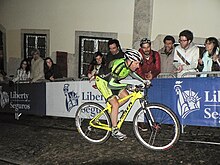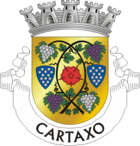Cartaxo
| Cartaxo | ||||||
|---|---|---|---|---|---|---|
|
||||||
| Basic data | ||||||
| Region : | Alentejo | |||||
| Sub-region : | Lezíria do Tejo | |||||
| District : | Santarém | |||||
| Concelho : | Cartaxo | |||||
| Freguesia : | União das Freguesias do Cartaxo e Vale da Pinta | |||||
| Coordinates : | 39 ° 9 ′ N , 8 ° 47 ′ W | |||||
| Postal code : | 2070 | |||||
| politics | ||||||
| Website: | www.cartaxo.freguesias.pt | |||||
| Cartaxo district | ||||||
|
||||||
| Residents: | 24,462 (as of June 30, 2011) | |||||
| Surface: | 158.18 km² (as of January 1, 2010) | |||||
| Population density : | 155 inhabitants per km² | |||||
| Number of municipalities : | 6th | |||||
| administration | ||||||
| Administration address: | Câmara Municipal de Cartaxo Praça 15 de December 2070-050 Cartaxo |
|||||
| President of the Câmara Municipal: | Pedro Miguel Magalhães Ribeiro ( PS ) | |||||
| Website: | www.cm-cartaxo.pt | |||||
Cartaxo is a district and a city in Portugal . The place is known for its wine.
On September 29, 2013, the municipalities of Cartaxo and Vale da Pinta were merged to form the new municipality of União das Freguesias do Cartaxo e Vale da Pinta .
history
The area has served people since prehistoric times as a connection from the coast to the inland, especially across the Tagus River . Some fortified settlements of the Castro culture have also been identified. The Romans who arrived later also settled here. The Roman road from Olisipo (today Lisbon ) via Lerabriga (today Alenquer ) to Scallabis (today Santarém ) crossed today's district area.
The area was the scene of fighting during the Arabs' conquest of the Visigoth Empire in 711, thanks in particular to its proximity to the contested fortress of Santarém. Christian armies also met the Moors here during the Reconquista . King D. Sancho II ordered the repopulation of the area, in particular to use the fertile soil.
Cartaxo received its first town charter in 1312, by King D. Dinis , which were confirmed in 1487. King D. Manuel I renewed the town charter in 1496 as part of his administrative reforms.
In 1656 Cartaxo was elevated to a small town ( Vila ). In 1815 it became the seat of its own circle, by decree of King D. João VI . At the time, the royal court resided in Rio de Janeiro , where it had moved on the run from the Napoleonic invasions . Towards the end of the 19th century, innovations in viticulture led to increased production in Cartaxo. The district's wine, which reached the capital via the Tagus River, was widely distributed there.
On June 21, 1995 Cartaxo was elevated to a city ( Cidade ).
administration
Cartaxo is the administrative seat of a district of the same name ( concelho ) in the Santarém district . The neighboring regions are (starting clockwise in the north): Santarém , Almeirim , Salvaterra de Magos and Azambuja .
With the regional reform in September 2013, several municipalities were merged into new municipalities, so that the number of municipalities decreased from eight to six.
The following municipalities ( Freguesias ) make up the Cartaxo district:
| local community | Population (2011) |
Area km² |
Density of population / km² |
LAU code |
|---|---|---|---|---|
| Cartaxo e Vale da Pinta | 12,665 | 28.23 | 449 | 140609 |
| Ereira e Lapa | 1,836 | 12.62 | 146 | 140610 |
| Pontevel | 4,614 | 27.84 | 166 | 140604 |
| Valada | 821 | 42.17 | 19th | 140605 |
| Vale da Pedra | 1,755 | 14.10 | 125 | 140608 |
| Vila Chã de Ourique | 2,771 | 33.22 | 83 | 140607 |
| Cartaxo district | 24,462 | 158.18 | 155 | 1406 |
Population development
| Population in Cartaxo County (1849–2011) | |||||||
|---|---|---|---|---|---|---|---|
| 1849 | 1900 | 1930 | 1960 | 1981 | 1991 | 2001 | 2011 |
| 7520 | 14,373 | 18,270 | 19,939 | 22,581 | 22,268 | 23,338 | 24,574 |
Municipal holiday
- Ascension of Christ
Town twinning
-
 Bento Gonçalves , Rio Grande do Sul, Brazil
Bento Gonçalves , Rio Grande do Sul, Brazil -
 Brava , Cape Verde
Brava , Cape Verde -
 Penglai , People's Republic of China
Penglai , People's Republic of China -
 Pucioasa , Romania
Pucioasa , Romania -
 Slupsk , Poland
Slupsk , Poland
traffic
Long-distance transport
Cartaxo is with the train stations Santana, Setil and Reguengo on the Linha do Norte , the most important railway line in the country.
The city is connected to the A1 motorway via the junction to the west at Aveiras de Cima (around 10 km away) and Vila Nova de São Pedro (around 5 km away) . The N3 national road also crosses Cartaxo. 10 km to the north there is a connection to the IC10 and the nearby A13 motorway .
The city is integrated into the national long-distance bus network of Rede Expressos .
Local public transport
The urban transport company Transporte Urbano do Cartaxo (TUC) operate a minibus line. In addition, private operators offer local and regional connections, especially the Rodoviária do Tejo .

sons and daughters of the town
- Cosme Delgado (1530–1596), composer
- Marcelino Mesquita (1856–1919), dramaturge and writer, doctor, politician and journalist
- José Tagarro (1902–1931), painter
- Alfredo Trindade (1908–1977), racing cyclist, winner of the Tour of Portugal in 1932 and 1933
- José Maria Nicolau (1908–1969), racing cyclist, winner of the Tour of Portugal in 1934
- António Montez (* 1941), actor, voice actor and theater director
- Fernanda Assis (* 1945), sculptor
- Francisco Valada , cyclist, winner of the Tour of Portugal in 1966
- Marco Chagas (* 1956), racing cyclist, multiple winner of the Tour of Portugal in the 1980s
- Gonçalo Amorim (1972–2012), cyclist
- Renato Silva (* 1976), racing cyclist
- Francisco Areosa (* 1986), triathlete, actor and voice actor
Web links
- Map of the Freguesia Cartaxo at the Instituto Geográfico do Exército
- Official website of the City of Cartaxo
Individual evidence
- ↑ www.ine.pt - indicator resident population by place of residence and sex; Decennial in the database of the Instituto Nacional de Estatística
- ↑ Overview of code assignments from Freguesias on epp.eurostat.ec.europa.eu
- ^ Publication of the administrative reorganization in the Diário da República gazette of January 28, 2013, accessed on October 1, 2014
- ↑ History page of the official website of the district administration , accessed on May 13, 2014
- ^ Publication of the administrative reorganization in the Diário da República gazette of January 28, 2013, accessed on March 16, 2014
- ^ Municipal website on the town twinning with Bento Gonçalves , accessed on May 13, 2014
- ^ Municipal website on the town twinning with Brava , accessed on May 13, 2014
- ^ Municipal website on the town twinning with Penglai , accessed on May 13, 2014
- ^ Municipal website on the town twinning with Pucioasa , accessed on May 13, 2014
- ^ Municipal website on the town twinning with Slupsk , accessed on May 13, 2014









